Shoot 'em ups are a sub-genre of action games. There is no consensus as to which design elements compose a shoot 'em up; some restrict the definition to games featuring spacecraft and certain types of character movement, while others allow a broader definition including characters on foot and a variety of perspectives.

Llamatron is a multidirectional shooter video game programmed by Jeff Minter of Llamasoft and released in 1991 for the Atari ST and Amiga and in 1992 for MS-DOS. Based on Robotron: 2084, players of Llamatron control the eponymous creature in an attempt to stop an alien invasion of Earth and rescue animals—referred to as "Beasties"—for points. Players advance by destroying all of the enemies on each level using a laser that fires automatically in the direction that the Llamatron is moving. Various power-ups exist to aid the player in defeating the wide variety of enemies and obstacles they face along the way.

Stargate is a horizontally scrolling shooter released as an arcade video game in 1981 by Williams Electronics. Created by Eugene Jarvis and Larry DeMar, it is a sequel to Defender which was released earlier in the year. It was the first of only three productions from Vid Kidz, an independent development house formed by Jarvis and DeMar. Some home ports of Stargate were renamed to Defender II for legal reasons.
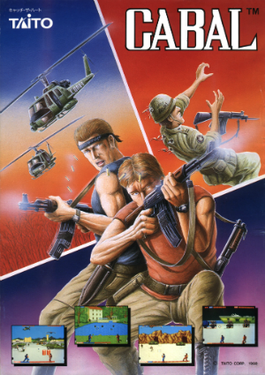
Cabal is a 1988 arcade shooter video game originally developed by TAD Corporation and published in Japan by Taito, in North America by Fabtek and in Europe by Capcom. In the game, the player controls a commando, viewed from behind, trying to destroy various enemy military bases. The game was innovative for the era, but only a mild success in the arcades, and became better known for its various home conversions.

Communist Mutants from Space is a fixed shooter video game programmed by Stephen H. Landrum for the Atari 2600 with the Starpath Supercharger cassette accessory. It was published in 1982 by Starpath. The game is similar to Galaxian, adding a variety of gameplay-changing options.
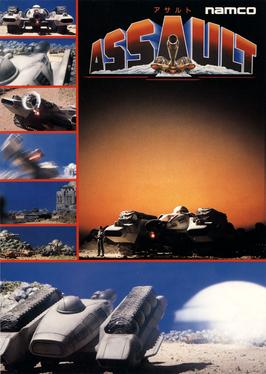
Assault is a 1988 multi-directional shooter arcade game developed and published by Namco. It was licensed to Atari Games for release in North America. Controlling a caterpillar-tread self-propelled gun, the player is tasked with completing each of the game's eleven stages while shooting enemies and avoiding projectiles. It uses a twin-stick control layout, similar to games such as Battlezone. The plot involves the human race searching for new planets after Earth reaches its maximum population - after discovering an exo-planet 35,000 light years away from the Milky Way, they enslave the planet's natives and take control, leading to the planet's native population vowing to abolish the humans and bring peace to their world. The protagonist who rides the aforementioned self-propelled gun which players control, is one such native.
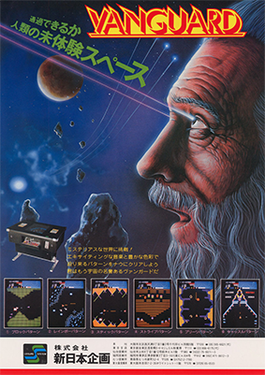
Vanguard is a scrolling shooter arcade video game developed by TOSE. It was released by SNK in Japan and Europe 1981, and licensed to Centuri for manufacture in North America in October and to Zaccaria in Italy the same year. Cinematronics converted the game to cocktail arcade cabinets in North America.

Blue Max is a scrolling shooter written by Bob Polin for Atari 8-bit computers and published by Synapse Software in 1983. It was released for the Commodore 64 the same year. U.S. Gold published the Commodore 64 version in the UK in 1984 and ported the game to the ZX Spectrum. In 1987, Atari Corporation published Blue Max as a cartridge styled for the then-new Atari XEGS.

Astro Chase is a multidirectional shooter written by Fernando Herrera for Atari 8-bit computers. It was published by First Star Software in 1982 as the company's first game. Parker Brothers licensed it, releasing cartridge versions for the Atari 8-bit family and Atari 5200 console in 1983 and a Commodore 64 version in 1984. Exidy licensed it for arcade use with its Max-A-Flex cabinet.

Fort Apocalypse is a multidirectional scrolling shooter for Atari 8-bit computers created by Steve Hales and published by Synapse Software in 1982. Joe Vierra ported it to the Commodore 64 the same year. The player navigates an underground prison in a helicopter, destroying or avoiding enemies and rescuing prisoners. A contemporary of Choplifter, it has similarities to that game as well as the arcade games Scramble and Super Cobra.

Escape from the Planet of the Robot Monsters is a multidirectional shooter released in arcades by Atari Games in 1989. The game is styled after campy science fiction B movies of the 1950s. It was ported to the Amiga, Amstrad CPC, Atari ST, Commodore 64, MS-DOS, SAM Coupé, and ZX Spectrum.
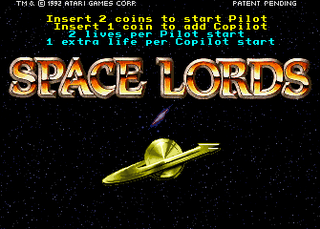
Space Lords is a video game released in arcades by Atari Games in 1992. It is a first-person perspective space combat video game.
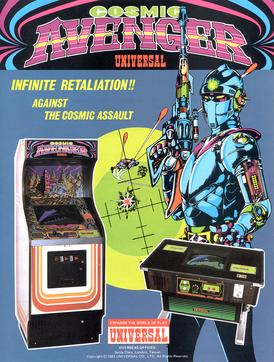
Cosmic Avenger is a scrolling shooter developed by Universal and released as an arcade video game in July 1981. It is part of the first wave shooters with forced horizontal scrolling which followed Konami's Scramble and Super Cobra from earlier in the year. It was released the same month as Vanguard. The final installment in Universal's Cosmic series, players take control of the Avenger space fighter and, as in Scramble, use bullets and bombs against enemy air and ground forces. The world is one continuous level made up of different areas.
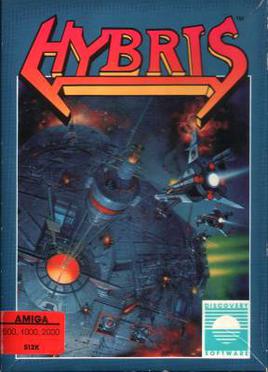
Hybris is a vertically scrolling shooter for the Amiga home computer developed by Cope-Com and published by Discovery Software.
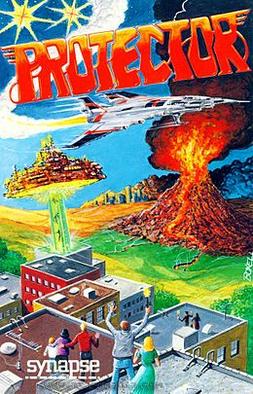
Protector is a 1981 scrolling shooter for Atari 8-bit computers programmed by Mike Potter and distributed first by Crystalware and then Synapse Software. A VIC-20 port was published by HesWare in 1983.

Attack at EP-CYG-4 is a shoot 'em up video game created by Mike Edwards for Atari 8-bit computers and published by his company BRAM, Inc. in 1982. It allows two players to cooperatively control the action against a computer enemy, in a fashion similar to Synapse Software's Survivor, also released in 1982. EP-CYG-4 was the first of Edwards' game efforts, and its success led to the creation of Zombies, which was published by Electronic Arts as Realm of Impossibility.

Shadow World is a shoot 'em up for Atari 8-bit computers written by Mike Potter and published by Synapse Software in 1983. Players are defending their planet from an alien invasion. The game supports two players at once, splitting the screen vertically into two halves, and merging them on the fly when both players are in the same location.

Slime is an action game for Atari 8-bit computers written by Steve Hales and published by Synapse Software in 1982. The player attempts to protect their ship from a rain of enormous drops of slime by deflecting them into canisters, while fending off attacks by an alien flying saucer. A TI-99/4A port was developed as Super Storm, but not released.

Boulders and Bombs is a video game for Atari 8-bit computers published on cartridge by CBS Software in 1983. It was written by Keith Dreyer and Torre Meeder who previously developed the Berzerk-clone K-Razy Shoot-Out. In Boulders and Bombs, the player must dig tunnels so three people can cross from one side of the screen to the other. Bird-like creatures, flying in the upper portion of the screen, launch projectiles into the dirt to thwart the player. While there isn't a separate multiplayer mode, joysticks plugged into each of the remaining 1-3 ports can each control one of the birds. The game generally received poor reviews, with reviewers citing control issues and the lack of excitement.

Star Maze is a space-themed shooter taking place in a multidirectional scrolling maze published by Sir-Tech in 1982. It was written by Canadian programmer Gordon Eastman for the Apple II, based on a design by Robert Woodhead. Versions for the Atari 8-bit computers and Commodore 64 followed in 1983.




















